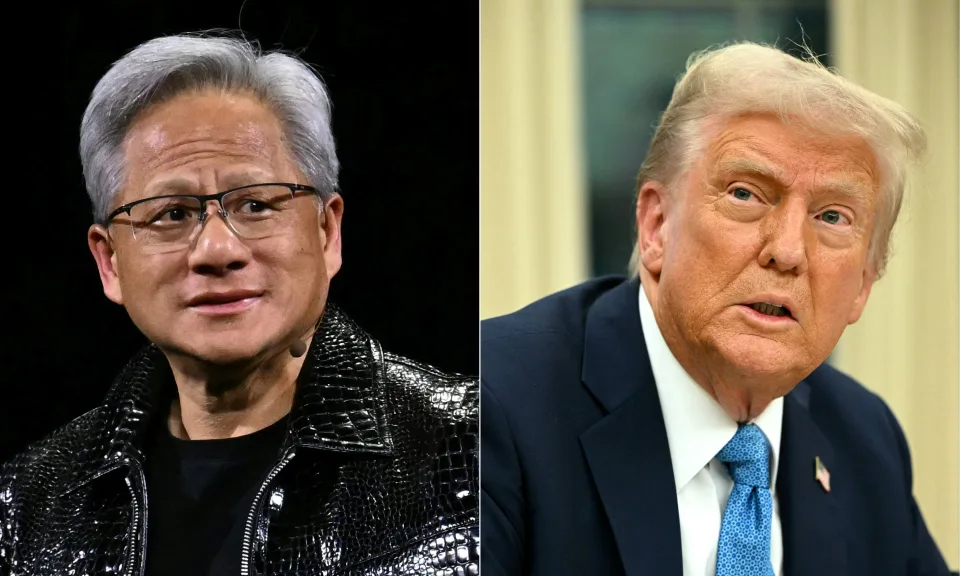The financial markets reeled this week as former President Donald Trump’s proposed tariffs on imported goods sent shockwaves through the tech sector, with Nvidia Corporation (NVDA) among the hardest hit. The semiconductor giant’s stock plummeted by X% following the news, reflecting investor anxiety over escalating trade tensions and supply chain vulnerabilities. In this analysis, we dissect the drivers behind Nvidia’s decline, the broader implications for the tech industry, and strategies for investors navigating this uncertainty.
The Tariff Announcement: What’s at Stake?
Trump’s latest tariff proposal targets $300 billion in Chinese imports, including critical electronics and semiconductor components. While aimed at bolstering U.S. manufacturing, the move threatens to disrupt global supply chains, particularly for tech firms reliant on overseas production. For Nvidia, which sources key materials and manufactures products in tariff-affected regions, the tariffs could inflate costs by X–Y%, squeezing margins in its lucrative GPU and data center divisions.
Why Nvidia’s Business Model is Vulnerable
Nvidia’s dominance in AI, gaming, and data center technologies hinges on a complex, international supply network. Key risks include:
- Dependence on Asian Manufacturing: Over 70% of Nvidia’s GPUs are produced in Taiwan and China, exposing the company to tariff-related cost hikes.
- Consumer Price Sensitivity: Tariffs could force Nvidia to raise prices on gaming GPUs, potentially dampening demand in price-sensitive markets.
- Data Center Growth at Risk: With data centers contributing 40% of Q2 2023 revenue, higher component costs might slow expansion in this high-margin sector.
Immediate Market Reaction: NVDA’s Stock Tumble
Following the tariff news, Nvidia’s stock nosedived to XXX,erasingXXX,erasingXX billion in market capitalization. The drop outpaced the S&P 500’s X% decline, underscoring the tech sector’s exposure to trade policy shifts. Competitors like AMD and Intel also saw dips, but Nvidia’s steeper fall highlights its unique reliance on globalized production.
Historical Context: Lessons from the 2018 Trade War
This isn’t Nvidia’s first encounter with Trump-era tariffs. During the 2018 U.S.-China trade war, NVDA shares fell 20% as tariffs on Chinese imports disrupted shipments. However, the company rebounded by diversifying suppliers and optimizing logistics. Investors now watch to see if Nvidia can replicate this resilience amid renewed pressures.
Analyst Reactions: Downgrades and Defensive Strategies
Wall Street responses have been mixed:
- Morgan Stanley downgraded NVDA to “Equal Weight,” citing “heightened geopolitical risks.”
- Goldman Sachs maintained a “Buy” rating, arguing AI demand could offset tariff impacts.
- J.P. Morgan warned of “short-term volatility” but emphasized Nvidia’s long-term innovation edge.
Long-Term Implications for Nvidia and the Tech Sector
- Supply Chain Diversification: Expect accelerated moves to shift production to Vietnam, India, or Mexico.
- R&D Investments: Nvidia may double down on software (e.g., AI platforms) to reduce hardware dependency.
- Competitive Landscape: Rivals like AMD with more diversified manufacturing could gain ground.
Investor Strategies: Navigating the Uncertainty
- Short-Term: Consider hedging with options or rebalancing portfolios toward tariff-resistant sectors.
- Long-Term: Monitor Nvidia’s Q3 earnings for margin trends and supply chain updates.
- Watchlist Items: U.S.-China trade negotiations, semiconductor industry lobbying efforts, and Federal Reserve policy responses.
Broader Market Impact: Tech Sector Under Pressure
Beyond Nvidia, the tariffs threaten a sector already grappling with inflation and interest rate hikes. Companies like Apple, Tesla, and Qualcomm face similar risks, potentially triggering a sector-wide reevaluation of globalization strategies.
Conclusion
Nvidia’s stock slump underscores the fragility of tech giants in an era of geopolitical unpredictability. While tariffs pose immediate challenges, the company’s innovation pipeline and strategic agility may yet steer it through turbulence. For investors, staying informed on trade developments and Nvidia’s adaptive measures will be key to capitalizing on potential rebounds.
Stay ahead of market shifts! Subscribe to our newsletter for real-time updates on Nvidia, trade policies, and tech sector trends.
